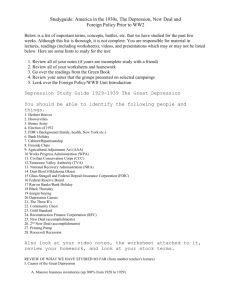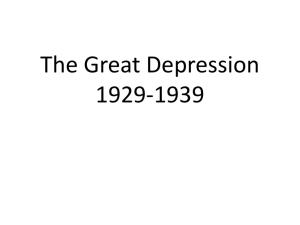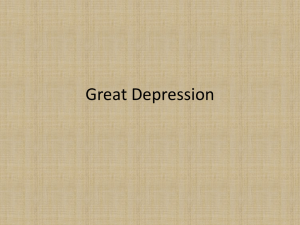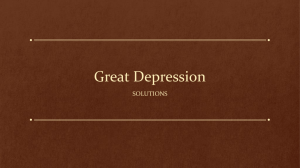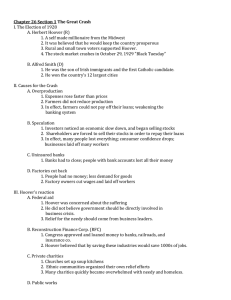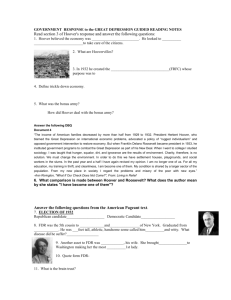The Great Depression - Warren County Schools
advertisement
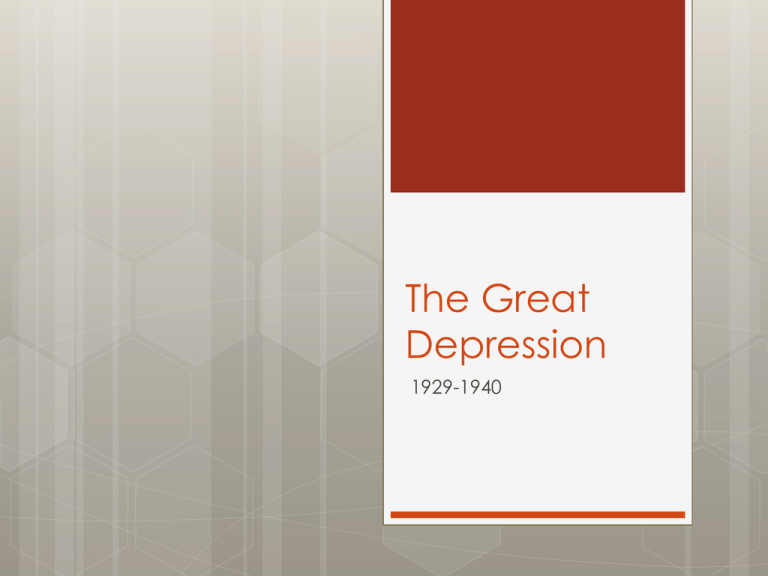
The Great Depression 1929-1940 Looming Economic Troubles • Troubled Industry ▫ ▫ • Railroads, textiles, coal mining, auto industry, and consumer goods were weakening or struggling The number of houses being built declined Farmers in debt Decline in crop prices lead to debt, foreclosures on farms and defaults on loans. Congress tried to pass federal price-supports to buy surplus wheat, corn, cotton and tobacco to sell on the world market. Hawley-Smoot Tariff 1930 Highest protective tariff in peace-time history Made trade from Europe extremely difficult • Consumer debt ▫ ▫ ▫ Prices were rising, wages weren’t Credit allowed consumers to spend outside their means plunging them into debt Businesses encouraged spending on credit, but consumers cut back spending to counteract debt “Rich got richer, poor got poorer” 0.1% of population with incomes more than $100,000; had 34% of nation’s savings 71% of population with incomes less than $2,500, the minimum to provide a decent standard of living 80% of population had no savings Large portion of population was in debt because of using credit to purchase new consumer goods Only 1/ 10 city homes owned an electric fridge The Election of 1928 Republican candidate Herbert Hoover against Democrat Alfred E. Smith Smith was more personable, but he was a Catholic , pro-alcohol, and from NYC “We in America are nearer to the final triumph over property than ever before.” Hoover wins an overwhelming victory The Stock Market • • Most visible symbol of a prosperous American economy The Dow Jones Industrial Average gauged the market’s health ▫ • The Dow is a measure based on the stock prices of 30 representative large firms that trade on the New York Stock Exchange Through the 20’s, stock prices rose. Dow reached a high of 381 points, an increase of 300 points in 5 years A Bull Market Widespread speculation where people bought stocks and bonds to make a quick profit Buying on margin where they would pay a small % of a stock’s price as a down payment and borrow the rest More people began to invest in the stock market, not just the wealthy If the value of stocks decline, people have no way to pay off loans Gov. didn’t try to regulate the market Black Thursday September 1929 – stock prices reached an alltime high Wed, October 23, 1929 – stock prices declined What would you do? • Thurs, October 24, 1929 – Nervous investors began selling stocks • Banks joined together to buy stock to prop up stock prices and the stock market. This worked, but for just a few days. • Mon, October 28, 1929 – stock prices started falling again • Black Tuesday Tues, October 29, 1929 Everyone rushed to sell their stock (get their money out of the stock market) Wide spread panic led to the dumping of 16.4 million shares of stock Stock market dropped in value by $16 Billion 211,942,040,062 today The stock market actually collapsed = The Great Crash Total loss of the Great Crash = $30 billion 397,391,325,116 today People who used credit to buy stocks faced huge debts and others lost their savings. Financial Collapse • • The Stock Market Crash signaled the beginning of the Great Depression Banks Fail ▫ ▫ ▫ ▫ • People rush to withdraw $ from banks, but some couldn’t because banks had invested their $ instocks 1929: 600 banks closed 1933: 11,000 banks had failed Millions lost savings because gov. didn’t protect or insure bank accounts Businesses Fail ▫ ▫ ▫ Between 1929-1932, GNP was cut from $104 billion to $59 billion 90,000 businesses went bankrupt including auto and railroad Unemployment in 1929 was 3% compared to 25% in 1933 (that’s 1 in 4 people w/o a job) Effects overseas Many countries still trying to recover from WWI devastated European economy Made it hard to export Am. Goods United States passed high tariffs to protect Am. Farmers from competition Causes of the Great Depression Tariffs and war debt policies cut down the foreign market for Am. Goods Overproduction (surplus) of farm goods The availability of easy credit An unequal distribution of income The Depression Hits Home In cities, people lost their jobs and were evicted from their homes Built shantytowns, little towns made of shacks Used car bodies, orange crates, piano boxes Poor dug through garbage cans, begged, or waited in soup kitchens or bread lines to get cheap or free food African Americans and Latinos Higher unemployment rates and they received the lowest pay Faced increased racial violence from whites competing for jobs 1933: 24 African Americans died by lynching Mexicans and Mexican Americans faced deportation The Dust Bowl • • Between 1929 and 1932, about 400,000 farms were lost to foreclosure Not only economic damages, but environmental ▫ • Land was overworked Drought and dust storms in the Midwest for much of the 1930s ▫ ▫ ▫ ▫ ▫ ▫ “Black Sunday” – worst dust storm – April 14, 1935 Dust would get into everything…kitchens, bedrooms, hair, nails, mouths Wrapped faces in damp rags to filter out the grit Nostrils with Vaseline to keep noses from clogging and bleeding “dust pneumonia” Many packed up families and headed west to California along Route 66 Click below for a video! ^ Click for a song Searching for Jobs HOBOS No federal system of direct relief Women and Children Canned food, sewed clothes, managed budget Many worked outside the home for less wages, but resented for taking jobs away from men By 1933, 2,600 schools had closed leaving thousands of children to work in sweatshops “Wild boys” hopped freight trains travelling the country for jobs, adventure, and to escape poverty Social and Psychological Effects • • • • • • Between1928 and 1932, the suicide rate rose by 30% Health declined because couldn’t afford the doctor Couldn’t afford college, others put off marriage and raising large families or having kids at all People gave food, clothing, and shelter to the needy Strengthened communities and family ties Developed habits of saving and thriftness President Herbert Hoover After the crash, he tried to convince public that the economy was on sound footing and to remain optimistic Opposed any form of federal welfare, or direct relief to the needy, because it would weaken their self-respect He asked employers not to cut wages or lay off works, he asked labor leaders not to demand higher wages or strike Hoovervilles and Shantytowns What did Hoover Do? He finally decided he had to do something… He got Congress to approve $2.25 billion for public works projects Hoover Arizona Dam on the Colorado River in Reconstruction Finance Corporation 1932 – under Hoover Government lending bank to help smaller, rural banks Bonus Army of 1932 Veterans marched on Washington DC to demand their bonus from services during WWI Hoover sent Douglas MacArthur in to remove the veterans who would not leave using tear gas and bayonets ELECTION OF 1932 Herbert Hoover (Republican) “Prosperity is Just Around the Corner” Franklin D. Roosevelt (Democrat) Roosevelt’s theme song was “Happy Days are Here Again” He used his “Brain Trust” of trusted aides to help write speeches, etc. March 4, 1933 FDR was inaugurated President, 4 months after the election Worked with the Brain Trust to provide a “New Deal for the American people” during this time NEW DEAL His first Hundred Days were filled with legislation, over 15 pieces of major legislation Expanded March the role of the federal government 6-10 Nationwide Bank Holiday Closed all banks to prevent withdrawls Passed the Emergency Banking Relief Act to inspect the country’s banks Banks that couldn’t pay debts remained closed, restored confidence 3 Rs – Relief, Recovery, and Reform Relief – short range goals Recovery Reform – long range goals – deal with current abuses CONGRESS worked with the President and gave him “blank check” powers Emergency Banking Relief Act of 1933 Power to regulate the banking system Close and reopen banks Safer to keep money in a reopened bank than in the back yard! Fireside Chats Roosevelt used the radio to talk to Americans Focused Pump Click on Priming the picture for his first fireside chat during the bank holiday Glass-Steagall Banking Reform Act FDIC – Federal Deposit Insurance Corporation Insures individuals up to $5,000 Nation taken off the Gold Standard Civilian Conservation Corps (CCC) Most popular of all the New Deal alphabet agencies… Employment in fresh air government camps for about 3 million uniformed young men Reforestation, firefighting, flood control, swamp drainage Paid $30 a month, sent $25 home to their families Federal Emergency Relief Act (May 1933) Harry L. Hopkins $3 billion to states for work projects Agricultural Adjustment Act (AAA)– help farmers meet mortgages & paid farmers to grow less Home Owners’ Loan Corporation (HOLC) – to refinance mortgages on non-farm homes Tennessee Valley Authority (TVA)— renovated five damns and constructed 20 new ones. Created jobs, provided flood control, hydroelectric power Civil Works Administration (CWA) Provided 4 million temporary jobs during cruel winter months Built 40,000 schools and half a million roads Some people hated the New Deal Didn’t go far enough to help the poor and reform the economic system FDR spent too much on direct relief and used New Deal to control business and socialize economy Huey Long—Share-Our-Wealth promised “Every Man a King” Had 7.5 million members until he was assassinated Father Charles Coughlin – Catholic priest who became anti Semitic Broadcasted on radio economic, political, and religious ideas The Supreme Court Struck down two New Deal acts because federal government overstepped their roles FDR tried to pass a court-reform bill in 1937 reorganizing the federal judiciary and appoint new justices Criticized it upset judicial independence and checks and balances Over next four years, FDR appointed 7 new justices from resignations Second Hundred Days (or Second New Deal) Spring 1935 More relief for farmers and workers Eleanor Roosevelt travelled the country to remind her husband of the suffering 1936 election FDR wins overwhelmingly 1st time African Americans voted solidly Democratic and labor unions supported a candidate Works Progress Administration (WPA) 1935 Employment on useful projects $11 billion spent to give jobs to over 8 million workers WKU’s Cherry Hall was a recipient of the WPA money and workers Federal Art Project was also started Chronicling the Depression Artists, Painters, Filmmakers, Photographers showed a new interest in social problems and activism. Dorothea Lange – Photographic chronicler of the Great Depression Wagner Act 1935 Protected right of workers to join unions and collective bargain Prohibited unfair labor practices like threatening workers, firing union members, and interfering with union organizing 1938 Fair Labor Standards Act Set maximum hours at 44 and minimum wage at $0.25 Set rules for 16 and under, and banned dangerous work for under 18 Social Securities Act 1935 Old-age insurance for retirees 65 or older and their spouses Unemployment compensation system $15-$18 a week Aid to families with dependent children and the disabled Rural Electrification Administration 1935 Brought electricity to isolated areas In 1935, only 12.6% of American farms had electricity 48% in 1945, 90% in 1949 New Roles for Women More women working outside of home Frances Perkins Secretary of labor– First woman to head an executive department Helped create the Social Security system Mary McLeod Bethune Leader of the Black Cabinet and director of Negro Affairs in the National Youth Administration Advised FDR on racial issues and made provided job training and benefits to minority students Movies—65% 1x a week of population attending “Mr. Smith Goes to Washington” Disney – “Snow White” “Gone with the Wind” “The Wizard of Oz” Radio—90% of homes had a radio New Type of Music Emerging - “Swing” Radio programs such as The Lone Ranger & Orson Welles “War of the Worlds” Literature John Steinbeck’s The Grapes of Wrath Zora Neale Hurston’s Their Eyes Were Watching God Sports Boxing was hugely popular—Joe Louis Why would radio and movies increase in popularity? Culture American Gothic by Grant Wood 1937 A Troubled Year Moving Forward Supreme court upheld many New Deal programs March 1937 upheld a Washington law that granted Minimum Wage Ruled both, a key part of the Wagner Act and Social Security constitutional. Farm Tenancy Act - 1937 Gave tenant farmers and Sharecroppers a chance to buy land of their own Recovery in Doubt FDR scaled back federal deficit spending 1937 - A bad year for recovery. Massive drop in stocks and by the end of the year another 2 million American unemployed. Impact of the New Deal Relief, Recovery, Reform Which area was the New Deal most successful? Changing relationships Changed the link between the American people and the Government New Role for Government meant a much larger Government. As a result many more people now looked to the Government for help End of the New Deal Weakened What happened in 1937 to cause loss of support? The 1938 Election Republicans and Southern Democrats gained seats in the House and the Senate Why did this happen? After support – 1937 the New Deal After 1938 FDR lacked the support to pass New Deal Styled programs. Problems in Europe now held the attention of the American Public. In 1939 and 1940 international conflict will ultimately do what FDR’s programs could not.
